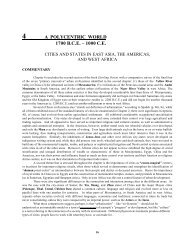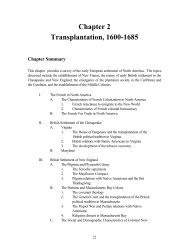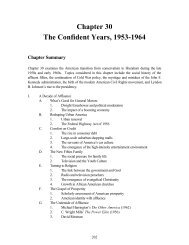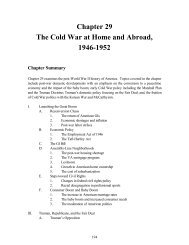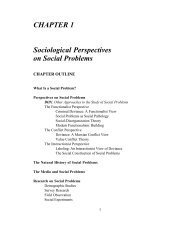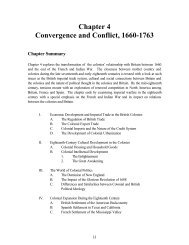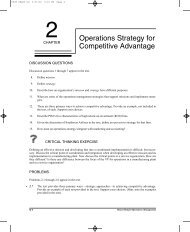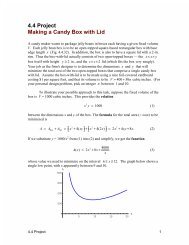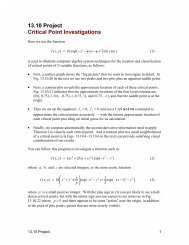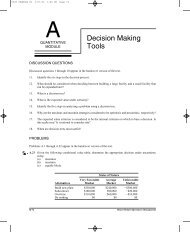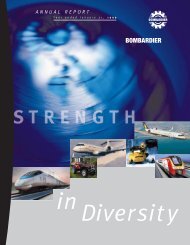Merchandising Operations and the Accounting Cycle - Pearson
Merchandising Operations and the Accounting Cycle - Pearson
Merchandising Operations and the Accounting Cycle - Pearson
You also want an ePaper? Increase the reach of your titles
YUMPU automatically turns print PDFs into web optimized ePapers that Google loves.
Required<br />
1. Inventory on h<strong>and</strong> at September 30, 2002, was $11,000. Without completing a<br />
formal accounting work sheet, prepare <strong>the</strong> company’s multi-step income statement<br />
for <strong>the</strong> year ended September 30, 2003.<br />
2. Compute <strong>the</strong> gross margin percentage <strong>and</strong> <strong>the</strong> inventory turnover for 2003. For<br />
2002, Yellowknife Trading Company Ltd.’s gross margin percentage was 60 percent<br />
<strong>and</strong> <strong>the</strong> inventory turnover rate was 9.8 times. Does <strong>the</strong> two-year trend in<br />
<strong>the</strong>se ratios suggest improvement or deterioration in profitability?<br />
Problem 5-9B Computing cost of goods sold <strong>and</strong> gross margin in a periodic system; evaluating<br />
<strong>the</strong> business (Obj. 5, 6)<br />
Selected accounts from <strong>the</strong> accounting records of PEI Products Ltd. at June 30, 2004,<br />
are shown below.<br />
Cash..................................................................................... $ 6,800<br />
Purchases of inventory ..................................................... 49,050<br />
Freight in............................................................................. 2,150<br />
Sales revenue...................................................................... 89,550<br />
Purchases returns <strong>and</strong> allowances.................................. 700<br />
Salary payable.................................................................... 900<br />
Common stock................................................................... 5,000<br />
Retained earnings.............................................................. 13,000<br />
Sales returns <strong>and</strong> allowances........................................... 6,050<br />
Inventory: June 30, 2003 .................................................. 11,900<br />
June 30, 2004 .................................................. 14,250<br />
Selling expenses................................................................. 14,900<br />
Equipment.......................................................................... 22,350<br />
Purchase discounts............................................................ 650<br />
Accumulated amortization—equipment....................... 3,450<br />
Sales discounts................................................................... 1,700<br />
General expenses............................................................... 8,150<br />
Accounts payable .............................................................. 11,900<br />
Required<br />
1. Show <strong>the</strong> computation of PEI Products Ltd.’s net sales, cost of goods sold, <strong>and</strong><br />
gross margin for <strong>the</strong> year ended June 30, 2004.<br />
2. Jake Bradshaw, manager of PEI Products Ltd. strives to earn a gross margin percentage<br />
of 40 percent. Did he achieve this goal?<br />
3. Did <strong>the</strong> rate of inventory turnover reach <strong>the</strong> industry average of 3.4 times per year?<br />
Problem 5-10B Under <strong>the</strong> perpetual inventory system, accounting for <strong>the</strong> purchase <strong>and</strong><br />
sale of inventory, computing cost of goods sold <strong>and</strong> gross margin, using<br />
<strong>the</strong> gross margin percentage to evaluate a business (Obj. 2, 5, 6)<br />
Century Life Products Ltd. uses <strong>the</strong> perpetual inventory method in tracking its inventory<br />
purchases <strong>and</strong> sales. All sales that result in a return, allowance, or discount<br />
are tracked in separate accounts in order to give management <strong>the</strong> proper information<br />
to control operations. The following information is available for <strong>the</strong> month of<br />
April 2004:<br />
April 1 The balance of inventory on h<strong>and</strong> at <strong>the</strong> beginning of <strong>the</strong> month was $53,250.<br />
2 Purchased $6,000 of merch<strong>and</strong>ise from Muzac Corp., terms 2/10 n/30. The goods<br />
were expected to be resold for $13,500.<br />
4 Sold merch<strong>and</strong>ise for $9,000 to Delta Fitness Club Ltd., terms 2/10 n/60. The<br />
goods had a cost of $4,500 to Century.<br />
Chapter Five <strong>Merch<strong>and</strong>ising</strong> <strong>Operations</strong> <strong>and</strong> <strong>the</strong> <strong>Accounting</strong> <strong>Cycle</strong> 273



